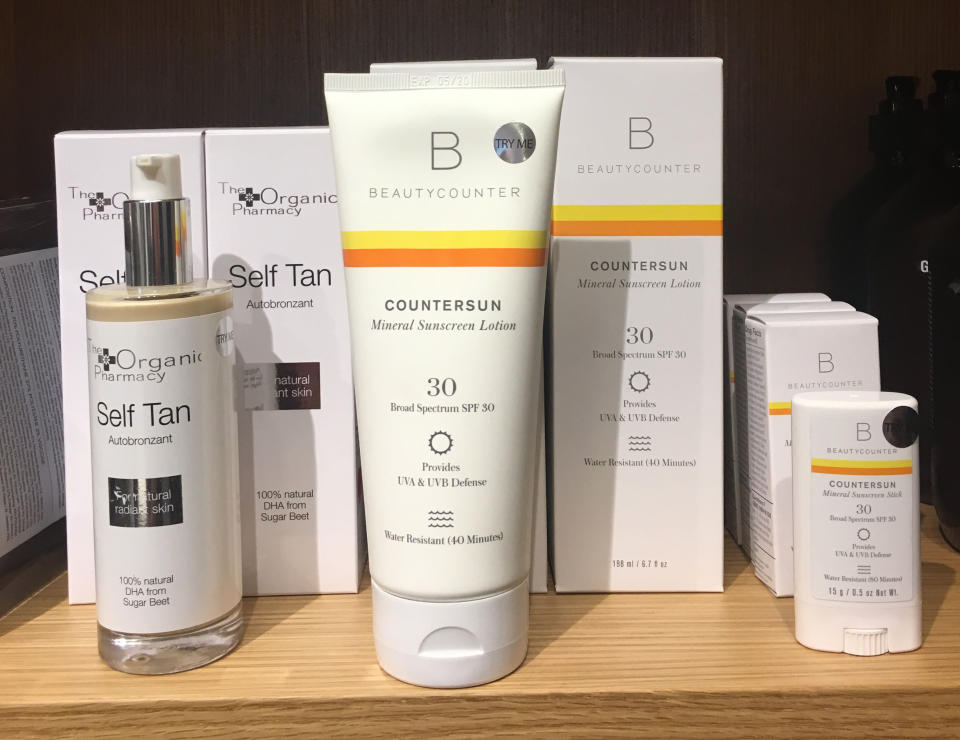Goop sunscreen controversy brings Health Canada loophole to light — here's what you need to know about sunscreen safety

Gwyneth Paltrow’s Goop made headlines after opening its first Canadian pop-up in Toronto recently, with Health Canada inspectors identifying two products that were not approved for sale in Canada.
It turned out that the Beautycounter brand sunscreens, which are labelled as having “natural ingredients,” were in fact compliant with Canadian regulations but had the wrong packaging, which was destined for the U.S.
The unfortunate mix-up revealed a loophole in Health Canada regulations: even though rules that surround the sale of natural health products in bricks-and-mortar stores are rigorous, the regulations are far looser when it comes to online shopping.
CBC News successfully ordered two product lines from Goop’s online storefront that are not licensed for sale in Canada. According to Health Canada, consumers can purchase unapproved natural health products online and ship to Canada as long as they are for personal use.
In other words, stores can sell natural health products that aren’t permitted for sale in a physical shop without any problem on its website.

Under Health Canada regulations, all natural health products must undergo testing to make sure they don't contain any harmful ingredients or anything that's not on the label in order to be legally sold in Canada. Once approved, those products are assigned a Natural Health Number, which appears on the label.
This loophole puts the onus on consumers to research and understand what’s in the products they’re using and reminds that just because something is natural doesn’t mean it’s safe or effective.
Health Canada’s rules on sunscreen say products cannot be called “sunblock” because nothing completely blocks the sun.
“Unfortunately, the word 'natural' can be misleading to consumers at times,” says Dr. Alanna Polo, a naturopathic physician owner of Polo Health + Longevity Centre in New Westminster, B.C. “Just because a sunscreen uses minerals which came from the earth, it doesn’t mean they haven’t been processed and refined by the time they are formulated into sunscreen.
“It’s important that consumers do their homework when shopping online,” she adds. “There is no real standard as to what can be called natural yet for the sunscreen industry, so you have to read the ingredients in order to make an educated decision.”
The Washington, D.C.-based Environmental Working Group’s Skin Deep Cosmetics Database is one reputable online resource that helps people learn what’s in the products they put on their bodies and that penetrate the skin, including sunscreen.
The database contains information about cosmetics ingredient restrictions in Canada, Japan, and the European Union. You can do searches of specific products or individual ingredients.
EWG has looked at existing data about human exposure and toxicity for the nine most commonly used sunscreen chemicals, the most worrisome being oxybenzone.
Widely used in nonmineral sunscreens, it can cause allergic skin reactions and is a potential endocrine disruptor.
It’s found in products like Aveeno Active Naturals Daily Moisturizing Lotion with Sunscreen, SPF 15, for example.
Other ingredients commonly found in sunscreens that need further testing for safety and efficacy are avobenzone, homosalate, octinoxate, octisalate, octocrylene, cinoxate, dioxybenzone, ensulizole, meradimate, padimate O and sulisobenzone.
EWG’s 2019 Guide to Sunscreens notes that even plant-based ingredients can be harmful and should meet the same safety standards as those derived from petroleum, mines, or animals.
Retinyl palmitate, for example, is a form of vitamin A, an antioxidant that combats skin aging.
However, it may also trigger the development of skin tumors and lesions when used on skin in the presence of sunlight. Some international agencies recommend against using cosmetics with vitamin A on the lips and large portions of the body, yet the ingredient can commonly be found in certain North American sunscreens.
EWG recommends consumers avoid sunscreens, lip products, and skin lotions containing vitamin A or retinyl palmitate, also known as retinyl acetate, retinyl linoleate, and retinol.
It recommends that consumers choose sunscreen lotions made with zinc oxide and titanium dioxide—but not in spray form.
Mineral sunscreens made with zinc oxide and titanium dioxide, usually in the form of nanoparticles. Evidence suggests that these particles are too small to penetrate the skin to reach living tissues but that they can be dangerous if inhaled in large amounts.

It’s also important that manufacturers use forms of minerals that are coated with inert chemicals to reduce photoactivity. If they don’t, could theoretically might suffer skin damage, although no such problems have been reported to date.
According to EWG, people should avoid products that claim a sun protection factor (SPF) higher than 50+. Excessively high SPF values give people a false sense of protection, potentially leading to overexposure to UVA rays that increase the risk of long-term skin damage and cancer.
A natural or mineral sunscreen will not have the same UV and UVB protection as a chemical-based sunscreen, Polo explains.
“Natural sunscreens deflect the suns rays instead of absorbing them like a chemical sunscreen,” she says. “If you decide to go with a natural sunscreen, make sure to use one that is at least SPF 40 or higher and remember to reapply frequently.
“I always recommend limiting sun exposure, and do whatever you can to stay protected—wear a hat, sit in the shade, and cover up,” she says.
Let us know what you think by commenting below and tweeting @YahooStyleCA! Follow us on Twitter and Instagram.



